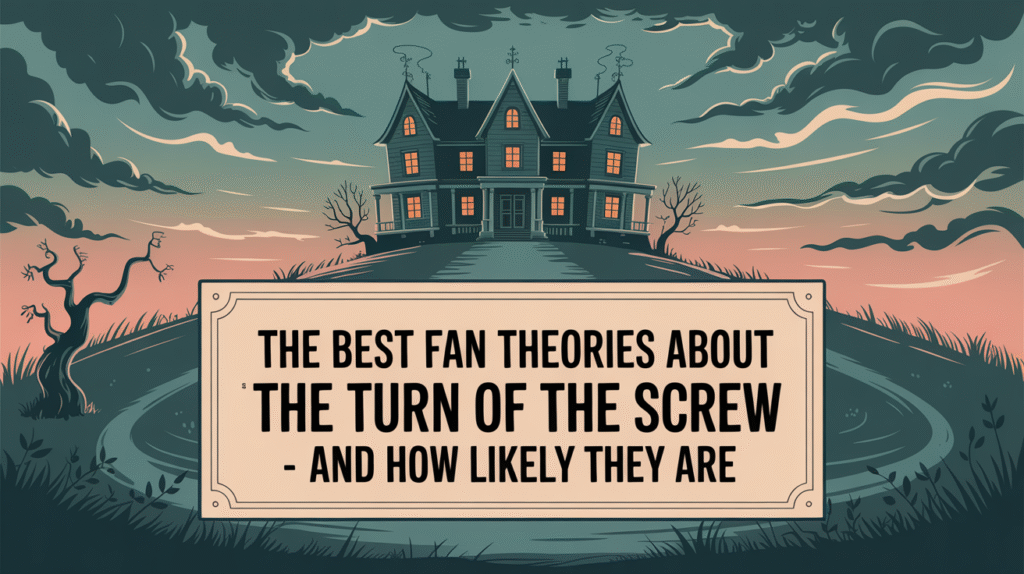The most compelling interpretations of “The Turn of the Screw” aren’t just found in the text, they’re crafted by readers. Fan theories help explain its eerie ambiguity, but how plausible are they?

Henry James’s The Turn of the Screw has sparked decades of speculation. With no definitive explanation for the governess’s visions, the children’s behavior, or the ghosts’ intentions, readers have developed countless fan theories to fill the gaps. Some are grounded in close reading, others in psychology, and a few even in horror tradition. Here’s a breakdown of the top fan theories, and how likely they are based on the text.
Theory 1: The Governess Is Mentally Ill and Imagining the Ghosts
This is the most widely accepted theory among modern critics and readers.
Supporting Clues
Numerous passages suggest the governess may be suffering from delusions or paranoia.
- She is the only one who ever sees the ghosts.
- Her reactions often seem exaggerated, especially in calm moments.
Psychological Interpretation
This theory interprets the story through a Freudian or modern psychological lens.
- Her emotional instability, isolation, and savior complex hint at underlying mental illness.
- The children’s supposed corruption may reflect her own internal struggles.
Likelihood: Very High
It’s the most textually supported theory and aligns with James’s known interest in psychological realism.
Theory 2: The Ghosts Are Real and Haunting the Children
Some readers take the story at face value, accepting that the ghosts of Peter Quint and Miss Jessel are genuine threats.
Evidence Within the Story
The governess describes the apparitions with detail and conviction.
- She recognizes Peter Quint without ever having seen him alive.
- The children’s behavior sometimes aligns suspiciously with her sightings.
Classic Gothic Tradition
This theory fits with traditional ghost stories, which James was clearly engaging with.
- The framing device encourages a supernatural reading.
- Ghosts symbolize real, external evil trying to reclaim the children.
Likelihood: Medium
While it matches the genre, the lack of independent verification weakens the case.
Theory 3: The Governess Is Jealous of Miss Jessel
Some theorists argue that the governess’s conflict is not with ghosts but with her own desires and insecurities, especially in comparison to the previous governess.
Suggestive Behavior and Language
The governess expresses strong emotions when Miss Jessel is mentioned or appears.
- Her descriptions of Miss Jessel are often charged and emotional.
- She may see Miss Jessel as a romantic or sexual rival.
Repressed Desires
The theory links to themes of Victorian repression.
- The governess’s emotional projection may be rooted in her own denied feelings for the children’s uncle.
- Miss Jessel becomes a scapegoat for the governess’s internal conflict.
Likelihood: High
This interpretation fits well with the novella’s psychological complexity and period context.
Theory 4: The Children Are Manipulating the Governess
Another popular fan theory claims Miles and Flora are more cunning than they seem, and are toying with the governess for their own reasons.
Behavior That Raises Questions
Some of their actions appear odd or too mature for their age.
- Miles’s cryptic comments and secrecy with his sister.
- Flora’s sudden illness after confrontation could suggest guilt.
Child-Centric Power Shift
The story can be read as a battle for control between the governess and the children.
- The governess may be the only one unaware of what’s truly happening.
- The children may have known more about Quint and Jessel than they let on.
Likelihood: Moderate
Though compelling, this theory lacks direct evidence and relies heavily on speculative interpretation.
Theory 5: The Uncle Is Behind Everything
A less common but intriguing theory suggests the absentee uncle may bear responsibility for the events.
His Refusal to Get Involved
The uncle explicitly instructs the governess not to contact him.
- This isolation leaves her vulnerable and unsupported.
- It could indicate he wants to cover something up.
Concealment of Past Events
He may have known more about Quint and Jessel than he admitted.
- Hiring a young, inexperienced governess may have been intentional.
- His absence raises questions about his role in the house’s history.
Likelihood: Low
While suspicious, there is little textual evidence to support this theory beyond his neglect.
FAQs About Fan Theories in The Turn of the Screw
Here are some questions and answers about the fan theories surrounding The Turn of the Screw:
Which theory does the author Henry James support?
Henry James never confirmed any interpretation. He stated that the story was meant to be ambiguous and open to multiple readings.
Are the ghosts meant to be real or symbolic?
Both interpretations are valid. The text supports supernatural and psychological explanations equally, depending on the reader’s focus.
Is the governess’s behavior justified?
Her decisions are open to interpretation. Some view her as a brave protector; others see her as delusional and harmful.
Why are there so many theories?
Because the story is intentionally vague and filled with conflicting signals. James wanted to provoke debate, not provide closure.
Can multiple theories be true at once?
Yes. Part of the novella’s brilliance is that it supports layered, even contradictory, interpretations. Psychological, supernatural, and symbolic readings can coexist.
The Turn of the Screw thrives on mystery, and its lasting legacy is partly due to the endless fan theories it inspires. Whether you believe in ghosts, psychological unraveling, or manipulative children, there’s enough ambiguity in James’s text to keep readers arguing, and rereading, for generations.
